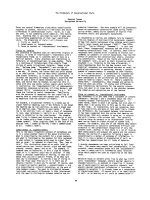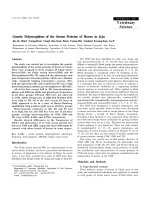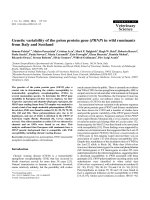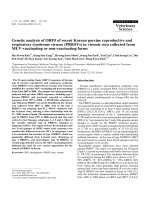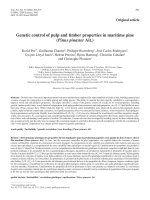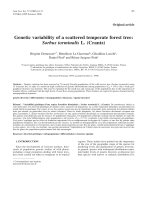Báo cáo khoa hoc:" Genetic parameters of spontaneous spring ovulatory activity in Mérinos d’Arles sheep Hanocq Loys Bodin Jacques Thimonier Jacques Teyssier Benoit Malpaux Philippe Chemineau " pptx
Bạn đang xem bản rút gọn của tài liệu. Xem và tải ngay bản đầy đủ của tài liệu tại đây (791.75 KB, 14 trang )
Original
article
Genetic
parameters
of
spontaneous
spring
ovulatory
activity
in
Mérinos
d’Arles
sheep
Eric
Hanocq
Loys
Bodin
Jacques
Thimonier
Jacques
Teyssier
Benoit
Malpaux
c
Philippe
Chemineau
a
Département
de
génétique
animale,
Station
d’amélioration
génétique
des
animaux,
Institut
national
de
la
recherche
agronomique,
31326
Castanet-Tolosan,
France
b
Unité
de
zootechnie
méditerranéenne,
École
nationale
supérieure
agronomique
de
Montpellier -
Institut
national
de
la
recherche
agronomique,
34060
Montpellier,
France
!
Neuroendocrinologie
sexuelle,
Physiologie
de
la
reproduction
des
mammifères
domestiques,
Institut
national
de
la
recherche
agronomique,
37380
Nouzilly,
France
(Received
23
July
1998;
accepted
5
November
1998)
Abstract -
The
genetic
parameters
of
spontaneous
spring
ovulatory
activity
were
investigated
in
the
Mérinos
d’Arles
breed
under
the
usual
pastoral
and
transhumant
management
conditions
of
this
breed
in
southeastern
France.
Ovulatory
activity
was
determined
by
assaying
the
plasma
progesterone
concentration
in
two
blood
samples
taken
8-10
days
apart.
The
data
set
consisted
of
1 887
ovulatory
activity
performance
measurements
in
1995,
1996
and
1997
on
933
ewes,
daughters
of
176
rams.
The
effects
of
the
’physiological
status’
(hoggets,
adult
ewes
with
or
without
lambing
in
the
previous
autumn),
age
and
live
weight
just
before
the
mating
period
were
found
to
be
highly
significant.
They
were
included
in
the
linear
animal
model
and
the
threshold
sire
model
used
to
estimate
genetic
parameters.
On
average,
27.9
%
of
ewes
exhibited
ovulatory
activity
in
April.
Age
and
live
weight
just
before
the
mating
period
had
a
marked
positive
effect
on
ovulatory
activity.
A
difference
of
about
8-9
%
was
observed
between
extreme
classes
for
these
factors.
The
heritability
and
repeatability
estimated
through
the
linear
model
were
0.20
(standard
error:
0.04)
and
0.30
(0.07),
respectively.
When
using
the
threshold
model,
the
heritability
was
0.37.
These
values
led
us
to
conclude
that
a
genetic
approach
for
improving
spontaneous
spring
ovulatory
activity
should
be
further
developed.
Nevertheless,
further
studies
are
necessary
to
determine
all
the
implications
of
such
selection.
©
Inra/Elsevier,
Paris
seasonality
/
reproduction
/
genetic
parameter
/
sheep
/
ovulation
*
Correspondence
and
reprints
E-mail:
fr
Résumé -
Paramètres
génétiques
de
l’activité
ovulatoire
spontanée
au
printemps
dans
la
race
ovine
Mérinos
d’Arles.
Les
paramètres
génétiques
de
l’activité
ovula-
toire
spontanée
au
printemps
ont
été
estimés
en
race
Mérinos
d’Arles
dans
le
système
d’élevage
pastoral
traditionnel
(transhumance
estivale)
du
sud-est
de
la
France.
Le
dosage
de
la
progestérone
plasmatique
dans
deux
prélèvements
sanguins
effectués
à
8-10 j
d’intervalle
a
permis
de
déterminer
l’activité
ovulatoire
des
brebis.
1887
per-
formances
d’activité
ovulatoire
ont
été
enregistrées
en
1995,
1996
et
1997,
sur
933
brebis
issues
de
176
béliers.
Le
«statut
physiologique
» (antenaises,
brebis
adultes
avec
ou
sans
mise
bas
à
l’automne
précédent),
l’âge
et
le
poids
au
moment
de
la
lutte
des
brebis
ont
des
effets
très
significatifs
sur
l’activité
ovulatoire.
Ils
ont
été
pris
en
compte
dans
le
modèle
animal
linéaire
et
le
modèle
père
à
seuil
utilisés
pour
estimer
les
paramètres
génétiques.
En
moyenne,
27,9
%
des
brebis
présentaient
une
activité
ovulatoire
en
avril.
L’âge
et
le
poids
au
moment
de
la
lutte
ont
un
net
effet
positif
sur
l’activité
ovulatoire.
Une
différence
de
8-9
%
a
été
observée
entre
les
classes
extrêmes
pour
ces
facteurs.
L’héritabilité
et
la
répétabilité
estimées
avec
le
modèle
linéaire
sont
de
0,20
(erreur
standard :
0,04)
et
de
0,30
(0,07),
respectivement.
L’héritabilité
cal-
culée
avec
le
modèle
à
seuil
est
de
0,37.
En
conclusion,
compte
tenu
de
ces
valeurs,
l’approche
génétique
visant
à
améliorer
l’activité
ovulatoire
spontanée
au
printemps
mérite
d’être
poursuivie.
Néanmoins,
d’autres
études
sont
nécessaires
pour
connaître
toutes
les
implications
que
supposent
une
telle
sélection.
©
Inra/Elsevier,
Paris
saisonnement
/
reproduction
/
paramètre
génétique
/
ovin
/
ovulation
1.
INTRODUCTION
Most
sheep
breeds
in
temperate
latitudes
are
seasonal
breeders.
Hafez
[14]
first
showed
differences
in
the
duration
of
breeding
seasons
in
British
breeds
raised
in
the
same
location.
Sexual
activities
of
females
and
males
are
influenced
by
changes
in
day
length
[30].
In
temperate
zones,
the
breeding
season
classically
corresponds
to
the
period
of
decrease
in
day
length,
especially
in
autumn.
For
economic
and
management
reasons
this
seasonality
may
be
a
handicap
for
farmers
and
processing
industries.
Control
of
the
breeding
period
is
possible
in
several
ways.
Hormonal
and/or
photoperiodic
treatments
[2,
3]
are
efficient
but
allow
only
a
partial
abolition
of
seasonality.
They
may
have
negative
consequences
on
the
future
efficiency
of
reproduction,
on
its
cost
and
on
the
image
of
the
product.
Bodin
et
al.
[1]
showed
a
lower
fertilisation
rate,
fertility
and
prolificacy
associated
with
repeated
PMSG
treatments.
The
use
of
the
’ram
effect’,
consisting
mainly
of
an
adequate
management
of
the
interactions
between
males
and
females
[27],
is
also
an
efficient
way
of
inducing
ovulatory
activity,
but
its
efficiency
may
be
limited,
especially
in
highly
seasonal
breeds.
For
the
ram
effect,
the
influences
of
genetic
factors
for
females
and
males
[28]
and
environmental
factors,
such
as
the
depth
of
the
seasonal
anestrus
[27]
or
the
presence
of
already
cyclic
ewes
[26,
32]
has
been
shown.
Moreover,
induced
oestrous
activity
may
be
quickly
followed
by
a
return
to
anestrus
[28].
Developing
a
genetic
approach
for
improving
the
out-of-season
breeding
ability
of
animals
(as
opposed
to
the
classical
breeding
season
in
sheep
in
temperate
latitudes)
may
be
an
interesting
way
of
controlling
the
seasonality
of
conception.
The
breeding
season
is
characterised
by
its
duration,
its
date
of
onset
and
its
date
of
cessation.
Various
authors
[17,
24,
37,
41]
have
mentioned
that
genes
control
a
part
of
the
existing
variability
in
these
traits.
Genetic
differences
between
breeds
and
between
individuals
within
a
breed
have
been
shown
[14].
Dyrmundsson
and
Adalsteinsson
[6]
have
shown
a
significant
effect
associated
with
a
coat-colour
gene
upon
out-of-season
sexual
activity.
Given
these
results,
a
genetic
approach
for
controlling
the
breeding
season
may
be
possible.
However,
the
out-of-season
breeding
ability
is
not
a
trait
that
is
easy
to
define
and
to
measure.
First,
for
practical
reasons,
such
as
interaction
with
reproduction,
cost
and
workload,
the
dates
of
onset
and
end
of
the
breeding
season
are
difficult
to
record
in
a
large
number
of
ewes,
especially
on
private
farms.
Then,
if
measurements
are
possible,
the
expression
of
out-of-season
breeding
ability
differs
according
to
the
criteria
used
for
its
measurement
and
the
environmental
context
in
which
it
is
studied.
Genetic
studies
may
be
based
on
the
performance
recorded
at
various
times
of
the
out-of-season
mating
period.
They
may
consist
in
detecting
ovulatory
or
oestrous
activities
and
necessitate
blood
samplings
and
hormone
assays,
or
heat
detection.
Depending
on
the
time
of
the
testing
and
its
duration,
such
measurements
make
it
possible
to
define
characteristics
of
the
breeding
season,
or
those
of
the
seasonal
anestrus.
Other
studies
may
be
based
on
fertility
performance
interpreted
as
a
result
of
the
out-of-season
breeding
ability
of
the
ewes.
When
detecting
heats
or
measuring
fertility,
except
if
males
are
in
the
flock
all
the
year
round
[5,
9],
joining
ewes
and
rams
induces
a
’ram
effect’.
It
is
then
impossible
to
separate
the
ewes
that
are
spontaneously
ovulating
from
those
responding
to
the
’ram
effect’.
Measuring
spontaneous
ovulatory
activity
before
any
attempt
at
induction
of
sexual
activity
prevents
confusion
[45].
The
value
of
studying
the
genetic
control
of
this
trait
is
reinforced
because
fertility
over
the
whole
mating
period
in
spring
increases
with
the
proportion
of
spontaneously
cyclic
ewes
before
joining
[18].
Thus,
the
purpose
of
our
study
was
to
estimate
the
genetic
parameters
of
spontaneous
spring
ovulatory
activity
in
the
M6rinos
d’Arles
breed
under
the
usual
pastoral
and
transhumant
management
conditions
of
this
breed
in
southeastern
France.
2.
MATERIALS
AND
METHODS
The
M6rinos
d’Arles
ewes
included
in
the
experiment
were
animals
of
the
experimental
flock
of
the
Domaine
du
Merle
located
in
southeastern
France
(43.5°N).
The
spontaneous
ovulatory
activity
of
the
ewes
was
determined
in
spring,
before
the
mating
period,
for
3
consecutive
years
(1995-1997).
2.1.
Management
system
In
the
past,
the
M6rinos
d’Arles
breed
was
used
for
wool
production.
It
shows
interesting
aptitudes
for
adaptation
to
its
environment
and
for
aseasonality.
These
aptitudes
are
fully
exploited
in
the
breeding
system
in
which
it
is
used,
i.e.
with
the
main,
or
the
only,
joining
season
in
spring,
just
before
transhumance
to
the
Alpine
mountains
in
summer.
In
the
experimental
flock
of
the
Domaine
du
Merle,
M6rinos
d’Arles
ewes
are
joined
from
15
April
to
15
June.
For
experimental
purposes,
a
large
number
of
the
ewes were
hormonally
synchronised
at
mating.
After
transhumance,
the
ewes
lambed
in
autumn.
Lambing
date
and
prolificacy
were
recorded.
Fertility
was
expressed
as
a
percentage
and
was
computed
as
the
number
of
ewes
which
lambed
in
autumn
compared
to
the
number
of
ewes
recorded
in
April.
Weaning
took
place
in
January.
Hoggets
were
mated
for
the
first
time
together
with
adult
ewes
when
18
months
old.
In
this
system,
with
one
lambing
per
year,
without
’cleanup’
breeding
in
autumn,
the
out-of-season
breeding
ability
of
ewes
in
spring
is
of
prime
importance.
In
this
experimental
flock,
ewes were
regularly
weighed.
The
live
weight
of
all
ewes
was
recorded
after
weaning
in
January
and
just
before
the
mating
period
in
April.
2.2.
Blood
sampling
and
hormone
assay
In
order
to
specifically
examine
the
spontaneous
ovulatory
activity,
the
ovulatory
activity
of
ewes
was
studied
before
any
reproduction
event,
i.e.
before
synchronisation
and/or
ram
introduction.
Two
jugular
blood
samples
per
ewe
were
collected,
at
an
interval
of
8-10
days,
during
the
first
2
weeks
of
April.
Blood
samples
were
centrifuged.
The
plasma
progesterone
concentration
was
assayed
by
radioimmunoassay
using
the
technique
described
by
Terqui
and
Thimonier
[43].
Ewes
with
at
least
one
sample
in
which
progesterone
was
higher
than
1
ng/mL
were
considered
as
being
in
ovulatory
activity
[44].
An
ovulatory
activity
score
of
1
was
thus
assigned
for
such
ewes
and
a
score
of
0
otherwise.
Most
of
the
ovulatory
cycles
within
the
normal
range
duration
were
detected.
However,
this
method
did
not
allow
the
detection
of
short
ovulatory
cycles
that
may
occur,
especially
at
the
onset
of
the
breeding
season.
2.3.
Animals
and
data
sets
The
whole
data
set
consisted
of
1
887
ovulatory
activity
records
(0
or
1)
measured
in
the
first
2
weeks
of
April
in
the
3
consecutive
years
of
the
experiment.
A
total
of
933
ewes,
daughters
of
176
rams,
were
included
in
the
experiment.
All
the
adult
ewes
in
the
flock
were
blood
sampled.
Ewes
could
be
studied
over
1
to
3
years
as
the
result
of
the
replacement
of
culled
or
removed
animals.
Thus,
241
ewes were
not
blood
sampled
in
the
1st
year
(table
1),
whereas
413
ewes were
not
blood
sampled
in
the
last
year.
A
total
of
293,
326
and
314
ewes were
blood
sampled
over
1,
2
and
3
years,
respectively.
The
pedigree
information
of
ewes
was
available
over
five
generations.
The
total
data
set
thus
involved
3 044
animals.
A
restricted
data
set
was
also
considered.
It
involved
only
the
first
record
of
each
ewe.
Thus,
this
data
set
consisted
of
933
records.
2.4.
Statistical
and
genetic
analyses
Potential
factors
affecting
the
variation
of
ovulatory
activity,
such
as
the
year
of
test,
the
age
of
ewes,
the
date
of
previous
lambing,
the
number
of
lambs
suckled,
the
live
weight
of
ewes
at
the
weaning
period
and
just
before
the
mating
period
and
its
variation
and
the
interaction
between
weight
and
age,
were
studied
through
an
analysis
of
variance.
Using
the
results
of
these
studies,
two
fixed
effects
were
defined
for
the
genetic
analysis.
The
first,
which
represents
the
’physiological
status’
had
nine
levels
corresponding
to
hoggets
(18
months),
ewes
without
lambing
in
the
previous
autumn,
and
seven
different
ages
(2.5-8.5
years
old)
for
ewes
dried-off
in
January.
The
second
effect
took
into
account
the
live
weight
just
before
the
mating
period
through
five
classes
defined
with
thresholds
of
41, 45,
49
and
55
kg.
Ovulatory
activity
follows
a
discrete
distribution
(0
or
1).
Theoretically,
the
optimum
method
of
analysis
would
have
been
to
analyse
it
as
categorical
data
using
a
non-linear
model.
Both
linear
and
non-linear
univariate
mixed
models
were
used
in
the
study.
A
linear
model
which
considered
the
trait
as
continuous
and
normally
distributed
made
it
possible
to
take
into
account
the
largest
quantity
of
pedigree
information
on
the
animals
via
an
animal
model.
Such
an
approach
is
widely
implemented
in
breeding
programmes.
The
non-linear
approach,
which
uses
the
threshold
model
developed
by
Gianola
and
Foulley
[12]
to
analyse
discrete
traits,
represents
the
method
of
choice
to
analyse
ovulatory
activity,
but,
as
recommended
for
theoretical
reasons,
only
a
sire
model
was
used.
The
linear
animal
model
was
written
as:
where
y
is
the
ewes’
performance
vector,
b
is
the
fixed
effect
vector
of
age
and/or
physiological
status
and
live
weight
just
before
the
mating
period,
a
is
the
random
effect
vector
of
animals,
p
is
the
random
effect
vector
associated
with
the
ewe
(the
permanent
effect
was
included
to
take
into
account
repeated
records),
e
is
the
random
residual
effect
vector
and
X,
Z
and
W are
the
incidence
matrices.
Random
factors
are
normally
distributed
with
the
following
expectation
and
variance-covariance
structure:
where
A
is
the
numerator
relationship
matrix
including
3 044
animals;
0’
a 2,
0
’;
p
2
and
a2
are
the
animal,
permanent
effect
and
residual
variances,
respectively.
Genetic
parameters
were
estimated
with
a
single
trait
restricted
maximum
likelihood
(REML)
analysis
fitted
to
the
linear
animal
model
described
in
equa-
tion
(1).
The
variance
component
estimation
(VCE)
3.2
programme
written
by
Groenveld
[13]
was
used.
Heritability
(h
2)
and
repeatability
(r)
were
obtained
from
the
estimated
variance
components
as
follows:
The
best
linear
unbiased
predictor
(BLUP)
for
the
fixed
and
the
random
effects
of
equation
(1)
was
computed.
It
used
the
variance
components
from
the
REML
analysis.
The
threshold
model
is
based
on
the
assumption
that
the
observed
values
(0
or
1
in
this
study)
are
related
to
an
underlying
Gaussian
variable,
usually
called
liability.
The
model
used
for
liability
was:
where
is
the
liability
vector,
b
is
the
fixed
effect
vector,
s
is
the
random
effect
vector
of
sires,
e*
is
the
random
residual
effect
vector
and
X
and
Z*
are
the
incidence
matrices.
The
expectation
and
variance-covariance
structure
was
as
follows:
where
As
is
the
numerator
relationship
restricted
to
the
sires
including
652
animals
and
Qs
is
the
sire
variance.
The
threshold
model
was
only
used
to
analyse
the
restricted
data
set.
Estimates
of
the
effects
of
the
model
and
of
variance
components
were
obtained
as
proposed
by
Gianola
and
Foulley
[12].
With
such
a
model,
heritability
computed
for
liability
(hE)
was
obtained
as
follows:
Heritabilities
obtained
on
the
observed
scale
and
on
the
underlying
scale
may
be
related
using
the
expression
proposed
by
Robertson
and
Lerner
[38]:
where
z
is
the
value
of
the
density
of
the
underlying
normal
distribution
at
the
threshold
point
corresponding
to
p,
p
being
the
mean
percentage
of
ewes
in
ovulatory
activity
in
the
flock.
3. RESULTS
3.1.
Phenotypic
means
For
the
3
years
(table
77),
27.9
%
of
the
ewes
presented
spontaneous
ovu-
latory
activity
in
April.
Percentages
were
very
similar
from
one
year
of
ex-
periment
to
another.
Among
the
314
ewes
measured
over
3
consecutive
years
(table
7),
142
ewes
were
never
ovulatory
and
32
were
always
in
ovulatory
activ-
ity
in
spring.
The
weight
just
before
the
mating
period
(table
II)
was
47.0
kg.
It
varied
from
46.2
in
1996
to
48.5
in
1997.
3.2.
Factors
of
variation
The
change
in
live
weight
between
the
drying-off
in
January
and
the
weigh-
ing
period
in
April
just
before
mating,
the
interaction
between
live
weight
and
age,
the
number
of
suckled
lambs
or
the
lambing
date
for
ewes
with
lambing
in
the
previous
autumn
were
found
to
have
no
significant
effect
on
ovulatory
activity
in
spring.
As
a
consequence,
only
live
weight
just
before
the
mating
period,
the
previous
physiological
status
and
the
age
for
ewes
dried-off
in
Jan-
uary
were
taken
into
account
in
the
analysis.
The
BLUP
estimates
for
fixed
effects
adjusted
to
the
phenotypic
mean
are
shown
in
figures
1 and
2.
The
effect
of
age
on
ovulatory
activity
(figure
1)
was
positive,
especially
for
young
ewes.
increase
of
about
8-9
%
in
the
ovulatory
activity
was
observed
in
2.5-
to
4.5-year-old
ewes.
After
4.5
years
of
age,
there
was
no
significant
difference
between
age
levels.
The
estimated
effect
of
live
weight
just
before
the
mating
period
on
ovulatory
activity
(figure
2)
showed
an
almost
null
effect
below
49
kg
and
a
marked
positive
effect
for
a
higher
weight.
A
difference
of
about
9
%
in
ovulatory
activity
was
observed
between
extreme
classes.
Estimates
of
fixed
effects
with
linear
and
threshold
models
were
consistent.
Age
and
live
weight
were
strongly
correlated
factors.
Although
the
interac-
tion
between
age
and
live
weight
was
not
statistically
significant,
it
was
never-
theless
studied.
The
joint
effects
of
age
and
weight
are
shown
in
figure
3;
for
the
sake
of
simplicity,
only
classes
of
age
2.5
and
3.5
are
shown.
Ovulatory
activity
increased
with
live
weight.
For
each
class,
a
threshold
effect,
characterised
by
a
clear
increase,
was
observed
(41
to
45
and
45
to
49
for
ages
2.5
and
3.5,
respectively).
3.3.
Genetic
analysis
The
heritability
of
spontaneous
spring
ovulatory
activity
estimated
with
a
linear
animal
model
in
M6rinos
d’Arles
ewes
was
h2
=
0.20
with
a
standard
error
of
0.04
(table
III).
The
estimate
of
repeatability
was
r
=
0.30
with
a
standard
error
of
0.07.
Heritability
in
the
threshold
sire
model
was
0.37.
The
approximate
value
obtained
with
equation
(7)
was
0.36.
3.4.
Relationship
with
reproductive
performance
In
the
experimental
flock
the
ewes were
involved
in
several
experiments.
Thus,
during
the
2
months
of
the
mating
period,
they
received
various
breed-
ing
treatments
according
to
the
needs
of
each
experiment.
Despite
this
het-
erogeneity,
fertility,
prolificacy
and
lambing
date
were
calculated.
Results
over
the
whole
mating
period
were
93.1
%,
137
and
6th
October,
respectively.
Slight
variations
between
years
existed
(except
for
fertility
in
1997).
With
such
a
mix-
ture
of
management
system,
no
relationship
was
found
between
out-of-season
ovulatory
activity
and
fertility,
prolificacy
or
lambing
date.
4.
DISCUSSION
AND
CONCLUSION
In
this
study,
the
previous
physiological
status,
live
weight
and
age
of
ewes
were
found
to
have
significant
effects
on
spontaneous
ovulatory
activity
in
April.
Ovulatory
activity
increased
with
live
weight
and
age.
The
youngest
females
included
in
the
analysis
were
18
months
old.
Thus,
performance
was
independent
of
any
influence
of
puberty.
Adult
ewes
(with
at
least
one
previous
lambing)
and
hoggets
were
consequently
analysed
together.
In
spite
of
a
slight
confounding
between
age
and
physiological
status
effects,
a
specific
influence
on
natural
ovulatory
activity
was
found
for
both
effects.
The
date
of
lambing
in
the
previous
autumn
was
found
to
have
no
influence
on
ovulatory
activity
in
spring.
However,
uterine
involution
is
complete
after
28
days
[46]
and
the
conception
rate
is
not
down
to
standard
after
40
to
50
days
post-partum
[4,
19,
42].
These
results
explain
why
a
post-partum
interval
of
about
8
months
(which
corresponds
to
a
one
lambing
per
year
reproduction
system)
cannot
have
an
effect
on
ovulatory
activity.
In
contrast,
shorter
intervals,
as
studied
by
Dzabirski
and
Notter
[7]
when
comparing
autumn
lambing
with
winter
lambing,
showed
a
clear
positive
effect
of
time
since
lambing.
In
a
linear
animal
model,
heritability
and
repeatability
were
estimated
at
0.20
and
0.30,
respectively.
These
values
are
quite
high
and
the
efficiency
of
selection
for
spring
breeding
ability
is
supported
by
these
results.
Even
if,
in
the
present
study,
the
exact
relation
of
the
period
of
measurements
(April)
to
the
whole
natural
breeding
period
is
unknown,
the
above
values
are
in
the
same
range
as
those
obtained
in
various
studies.
Heritability
estimates
for
the
date
of
onset,
the
date
of
cessation
or
the
duration
of
the
breeding
season
have
been
found
to
be
between
0.20
and
0.35
[8,
33-35].
These
values
are
slightly
higher
than
those
obtained
for
fertility
(0.13)
in
fall
lambing
by
Shelton
and
Menzies
(39],
Smith
et
al.
[40]
and
Notter
et
al.
[25],
but
the
latter
trait
may
be
considered
as
a
more
complex
trait
in
comparison
to
breeding
season
characteristics.
In
the
M6rinos
d’Arles
breed,
Razungles
et
al.
[36]
obtained
a
similar
heritability
(0.17)
for
fertility
in
spring,
but
lambings
were
from
both
ewes
with
spontaneous
ovarian
activity
and
ewes
ovulating
in
response
to
ram
introduction.
Heritability
was
consistently
larger
with
the
threshold
sire
model
than
with
the
linear
animal
model.
Gianola
[11]
showed
that
this
is
an
expected
result
when
comparing
both
theoretical
methods
when
the
layout
is
not
highly
unbalanced.
The
increase
was
in
accordance
with
that
expected
when
using
the
approach
of
Robertson
and
Lerner
[38].
This
trend
was
also
found
experimentally
when
estimating
genetic
parameters
for
reproductive
traits
in
sheep
[10,
21,
29].
Except
for
Meijering
and
Gianola
[22]
in
some
particular
unbalanced
situations
of
a
simulation
study,
the
efficiency
of
selection,
however,
is
usually
unchanged
when
using
a
linear
method
of
sire
evaluation
or
the
threshold
method.
In
the
present
experiment,
after
the
experimental
period,
some
ewes were
hormonally
synchronised
at
mating
and
the
expression
of
fertility
did
not
result
from
the
natural
out-of-season
breeding
ability.
Moreover,
even
in
the
case
of
natural
mating,
the
ewes
involved
in
different
experiments
had
various
breeding
treatments.
It
is
then
not
surprising
to
find
no
relation
between
spontaneous
ovulatory
activity
in
early
spring
and
reproductive
parameters
corresponding
to
the
following
mating
period.
Estimates
of
genetic
relationships
between
characteristics
of
seasonality
and
prolificacy
are
quite
scarce
and
will
require
further
studies
to
be
performed.
Purser
[33]
found
no
genetic
relationships
between
the
date
of
onset
of
the
breeding
season
and
the
litter
size,
whereas
Owen
et
al.
[31]
found
a
positive
genetic
correlation.
Dzabirski
and
Notter
[7]
reported
a
lower
prolificacy
for
ewes
with
spontaneous
ovulatory
activity
in
spring
probably
due
to
the
interaction
with
seasonal
variations
in
the
ovulation
rate
[16].
In
this
study,
the
spring
ovulatory
activity
just
before
mating
was
the
criterion
used
to
measure
the
out-of-season
breeding
ability
of
ewes.
A
more
detailed
analysis
of
the
ovulatory
activity
of
ewes
from
January
until
the
mating
period
has
to
be
performed
to
test
whether
the
spring
activity
corresponds
to
an
end,
an
onset
of
the
breeding
season,
a
sporadic
activity
or
a
continuous
activity
of
aseasonal
ewes.
With
a
clear
objective
to
select
truly
aseasonal
ewes,
measuring
ovulatory
activity
in
the
fully
out-of-season
period
appears
to
be
appropriate.
Selection
based
on
later
or
earlier
tests
could
only
induce
an
advanced
or
a
later
breeding
season,
and
thus
a
shifted
breeding
season
which
is
easier
to
obtain
than
a
permanent
sexual
activity
[24].
Nevertheless,
even
with
spring
testing,
there
is
a
risk
of
selecting
either
ewes
with
only
a
sporadic
activity
preceded
and
followed
by
anestrus
periods
as
observed
by
Thimonier
and
Maul6on
[45]
or
ewes
with
a
completely
changed
breeding
season
without
any
increase
in
the
duration.
In
selection
experiments,
Dzabirski
and
Notter
[7]
showed
an
advanced
date
of
lambing
in
autumn
for
ewes
with
spontaneous
ovulatory
activity
in
spring
in
comparison
to
ewes
responding
to
ram
introduction.
When
selecting
for
fall
lambing
fertility,
Notter
et
al.
[25]
mentioned
a
correlated
positive
response
in
the
extension
of
the
breeding
season.
Estimated
genetic
parameters
are
high
enough
to
allow
efficient
selection
on
the
studied
trait.
Estimates
were
based
on
a
large
number
of
records.
This
guarantees
good
reliability
of
the
results.
Nevertheless,
more
information
on
the
real
efficiency
of
such
selection
and
its
consequences
for
reproductive
performance
is
necessary.
Moreover,
further
physiological
and
genetic
studies
on
the
endocrine
mech-
anisms
controlling
seasonal
breeding
are
essential
to
better
control
the
conse-
quences
of
selection
and
to
improve
its
efficiency.
The
assumption
of
an
overall
and
common
factor
controlling
seasonal
variations
is
supported
by
various
stud-
ies.
For
instance,
correlated
response
in
changes
in
seasonal
breeding
were
ob-
served
by
Haley
et
al.
[15]
and
by
Montgomery
and
Hawker
[23]
when
selecting
for
out-of-season
testis
size
and
wool
growth,
respectively.
A
candidate
overall
factor
could
be
melatonin,
the
hormonal
messenger
by
which
animals
perceive
night
duration
and
then
seasonal
variations
[20].
In
addition,
Zarazaga
et
al.
[47]
showed
that
variability
in
the
night-time
melatonin
plasma
concentration
was
under
strong
genetic
control.
Studies
relating
such
melatonin
characteris-
tics
to
variations
in
classical
seasonal
breeding
traits
should
be
performed.
ACKNOWLEDGEMENTS
The
authors
wish
to
thank
the
staff
in
charge
of
the
Mérinos
d’Arles
flock
in
Le
Merle,
especially
C.
Lefevre,
P.
Bosc,
M.
Vincent
and
M.
Maillon,
the
RIA
laboratory
in
Nouzilly
for
performing
the
progesterone
assays
and
M.
San
Cristobal-Gaudy
for
her
computational
help.
An
Inra
programme
(ADELE-H)
partly
supported
this
study.
REFERENCES
[1]
Bodin
L.,
Drion
P.V.,
Remy
B.,
Brice
G.,
Cognié
Y.,
Beckers
J.F.,
Anti-
PMSG
antibody
levels
in
sheep
subjected
annually
to
oestrus
synchronisation,
Re-
prod.
Nutr.
Dev.
37
(1997)
651-660.
[2]
Chemineau
P.,
Malpaux
B.,
Pelletier
J.,
Leboeuf
B.,
Delgadillo
J.A.,
Dele-
tang
F.,
Pobel
T.,
Brice
G.,
Emploi
des
implants
de
m6latonine
et
des
traitements
photopériodiques
pour
maitriser
la
reproduction
saisonnière
chez
les
ovins
et
les
caprins,
Inra
Prod.
Anim.
9
(1996)
45-60.
[3]
Cognié
Y.,
Nouvelles
méthodes
utilisées
pour
améliorer
les
performances
de
reproduction
chez
les
ovins,
Inra
Prod.
Anim.
1
(1988)
83-92.
[4]
Dufour
J.J.,
Effects
of
season
on
postpartum
characteristics
of
sheep
being
selected
for
year-round
breeding
and
on
puberty
of
their
female
progeny,
Can.
J.
Anim.
Sci.
55
(1975)
487-492.
[5]
Dufour
J.J.,
Fahmy
M.H.,
Adelakoun
V.,
Matton
P.,
Ovarian
and
oestrous
activity
throughout
the
year
in
pregnant
and
nonpregnant
ewes
selected
for
extended
breeding
season,
Can.
J.
Anim.
Sci.
62
(1982)
1101-1108.
[6]
Dyrmundsson
O.R.,
Adalsteinsson
S.,
Coat-color
gene
suppresses
sexual
ac-
tivity
in
Icelandic
sheep,
J.
Hered.
71
(1980)
363-364.
[7]
Dzabirski
V.,
Notter
D.R.,
Effects
of
breed
and
time
since
lambing
on
spring
oestrous
activity
in
mature
ewes,
Anim.
Reprod.
Sci.
19
(1989)
99-108.
[8]
Fahmy
M.H.,
Genetic
parameters
of
date
of
lambing
in
‘DLS’
sheep,
in:
Barton
R.A.,
Smith
W.C.
(Eds.),
Proc.
World
Congr.
on
Sheep
and
Beef
Cattle
Breeding,
Palmerston
North,
New
Zealand,
1982,
pp.
401-404.
[9]
Fahmy
M.H.,
Dufour
J.J.,
The
breeding
season
and
ovulation
rate
of
DLS
ewes
as
determined
by
laparoscopy,
Can.
J.
Anim.
Sci.
66
(1986)
297-301.
[10]
Gates
P.J.,
Urioste
J.L,
Heritability
and
sire
genetic
trend
for
litter
size
in
Swedish
sheep
estimated
with
linear
and
threshold
models,
Acta
Agric.
Scand.
45
(1995)
228-235.
[11]
Gianola
D.,
Theory
and
analyses
of
threshold
characters,
J.
Anim.
Sci.
54
(1982) 1079-1096.
[12]
Gianola
D.,
Foulley
J.L.,
Sire
evaluation
for
ordered
categorical
data with
a
threshold
model,
Genet.
Sel.
Evol.
15
(1983)
201-224.
[13]
Groeneveld
E.
(Ed.),
REML
VCE -
a
multivariate
multimodel
restricted
maximum
likelihood
(co)variance
component
estimation
package,
Version
3.2,
User’s
Guide,
1996.
[14]
Hafez
E.S.E.,
Studies
on
the
breeding
season
and
reproduction
in
the
ewe,
J.
Agric.
Sci.
(Camb.)
42
(1952)
189-265.
[15]
Haley
C.S.,
Lee
G.J.,
Ritchie
M.,
Land
R.B.,
Direct
response
in
males
and
correlated
responses
for
reproduction
in
females
to
selection
for
testicular
size
adjusted
for
body
weight
in
young
male
lambs,
J.
Reprod.
Fertil.
89
(1990)
383-396.
[16]
Hall
D.G., Fogarty
N.M., Gilmour
A.R., Seasonality
of
ovulation
and
oestrus,
and
the
ram
effect
in
Poll
Dorset
ewes,
Theriogenology
25
(1986)
455-461.
[17]
Hanrahan
J.P.,
Genetic
variation
in
seasonal
reproduction
in
sheep,
in:
38th
EAAP
Annu.
Meeting,
Lisbon,
Portugal,
28
September-1
October
1987,
14
p.
[18]
Khaldi
G.,
Variations
saisonnières
de
1’activite
ovarienne,
du
comportement
d’oestrus
et
de
la
durée
de
1’anoestrus
postpartum
des
femelles
ovines
de
race
Barbarine :
influence
du
niveau
alimentaire
et
de
la
presence
du
male,
these,
Universite
de
Montpellier,
France,
1984,
168
p.
[19]
Land
R.B.,
The
incidence
of
oestrus
during
lactation
in
Finnish
Landrace,
Dorset
Horn
and
Finn-Dorset
sheep,
J.
Reprod.
Fertil.
24
(1971)
345-352.
[20]
Malpaux
B.,
Viguié
C.,
Skinner
D.C.,
Thiéry
J.C.,
Pelletier
J.,
Chemineau
P.,
Seasonal
breeding
in
sheep:
mechanism
of
action
of melatonin,
Anim.
Reprod.
Sci.
42
(1996)
109-117.
[21]
Matos
C.A.P.,
Thomas
D.L.,
Gianola
R.,
Tempelman
J.,
Young
L.D.,
Ge-
netic
analysis
of
discrete
reproductive
traits
in
sheep
using
linear
and
non-linear
models:
estimation
of
genetic
parameters,
J.
Anim.
Sci.
75
(1997)
76-87.
[22]
Meijering
A.,
Gianola
D.,
Linear
versus
non-linear
methods
of
sire
evaluation
for
categorical
traits:
a
simulation
study,
Genet.
Sel.
Evol.
17
(1985)
115-132.
[23]
Montgomery
G.W.,
Hawker
H.,
Seasonal
reproduction
in
ewes
selected
on
seasonal
changes
in
wool
growth,
J.
Reprod.
Fertil.
79
(1987)
207-213.
[24]
Notter
D.R.,
Manipulation
of
the
breeding
season
by
genetic
means,
in:
Burfening
P.J.,
Gabina
D.
(Eds.),
US-Spain
Seminar
on
Sheep
Breeding,
Zaragoza,
Spain,
10-15
November,
1986, 22
p.
[25]
Notter
D.R.,
Al-Shorepy
S.A.,
Vincent
J.N.,
Mc(auown
E.C.,
Selection
to
improve
fertility
in
fall
lambing,
in:
6th
WCGALP,
Armidale,
Australia,
11-16
January, 1998,
pp.
43-46.
[26]
Nugent
R.A.,
Notter
D.R.,
Effect
of
cohabitation
with
White-faced
ewes
on
oestrous
activity
of
Hampshire
and
Suffolk
ewes
exposed
to
rams
in
June,
J.
Anim.
Sci.
68
(1990)
1513-1519.
[27]
Oldham
C.M.,
Stimulation
of ovulation
in
seasonally
or
lactationally
anovular
ewes
by
rams,
in:
Proc.
Aust.
Soc.
Anim.
Prod.
13
(1980)
73-86.
[28]
Oldham
C.M.,
Cognié
Y.,
Do
ewes
continue
to
cycle
after
teasing?
in:
Proc.
Aust.
Soc.
Anim.
Prod.
13
(1980)
82-85.
[29]
Olesen
1., Perez-Enciso
M.,
Gianola
D.,
Thomas
D.L.,
A
comparison
of
nor-
mal
and
nonnormal
mixed
models
for
number
of
lambs
born
in
Norwegian
sheep,
J.
Anim.
Sci.
72
(1994)
1166-1173.
[30]
Ortavant
R.,
Pelletier
J.,
Ravault
J.P.,
Thimonier
J.,
Volland-Nail
P.,
Pho-
toperiod:
main
proximal
and
distal
factor
of
the
circannual
cycle
of
reproduction
in
farm
animals,
Oxford
Rev.
Reprod.
Biol.
7
(1985)
305-345.
[31]
Owen
J.B.,
Crees
S.R.E.,
Williams
J.C.,
Prolificacy
and
50-day
lamb
weight
of
ewes
in
the
Cambridge
sheep
breed,
Anim.
Prod.
42
(1986)
355-363.
[32]
Pearce
D.T.,
Oldham
C.M.,
The
ram
effect,
its
mechanism
and
application
to
the
management
of
sheep,
in:
Lindsay
D.R.,
Pearce
D.T.
(Eds.),
Reproduction
in
Sheep,
Australian
Academy
of
Science,
Canberra,
1984,
pp.
26-34.
[33]
Purser
A.F.,
Variations
in
date
of
first
oestrus
among
Welsh
Mountain
ewes,
in:
Proc.
Br.
Soc.
Anim.
Prod.
133
(1972)
(abstr).
[34]
Quirke
J.F., Hanrahan
J.P.,
Breed
differences
in
the
breeding
season
in
sheep,
Curr.
Top.
Vet.
Med.
Anim.
Sci.
31
(1985)
29-43.
[35]
Quirke
J.F.,
Hanrahan
J.P.,
Loughnane
W.,
Triggs
R.,
Components
of
the
breeding
and
non-breeding
seasons
in
sheep:
breed
effects
and
repeatability,
Irish
J.
Agric.
Res.
25
(1986)
167-172.
[36]
Razungles
J.,
Ricordeau
G.,
Tchamitchian
L.,
Prud’hon
M.,
Variations
génétiques
de
la
fertilite
des
brebis
M6rinos
d’Arles,
Ann.
Genet.
Sel.
Anim.
7
(1975)
409-419.
[37]
Ricordeau
G.,
Selection
for
reduced
seasonality
and
post-partum
anestrus,
in:
2nd
WCGALP,
Madrid,
Spain,
1982,
pp.
338-347.
[38]
Robertson
A.,
Lerner
LM.,
The
heritability
of all-or-none
traits:
viability
of
poultry,
Genetics
34
(1949)
395-411.
[39]
Shelton
M.,
Menzies
J.W.,
Repeatability
and
heritability
of
components
of
reproductive
efficiency
in
fine-wool
sheep,
J.
Anim.
Sci.
30
(1970)
1-5.
[40]
Smith
J.F.,
Johnson
D.L.,
Reid
T.C.,
Genetic
parameters
and
performance
of
flocks
selected
for
advanced
lambing
date,
in:
Proc.
New
Zealand
Soc.
Anim.
Prod.
52
(1992)
50
(abstr).
[41]
Tchamitchian
L.,
Choix
du
moment
et
du
rythme
de
reproduction,
Possi-
bilités
de
la
génétique,
in:
Proc.
of
3rd
World
Congr.
on
Sheep
and
Beef
Cattle
Breeding,
Paris,
19-23
June,
Inra
Publ.,
Paris,
1988,
pp.
529-546.
[42]
Tchamitchian
L.,
Ricordeau
G,
Lefèvre
C,
Desvignes
A.,
Observations
sur
I’anoestrus
postpartum
des
brebis
Romanov
après
un
agnelage
en
saison
sexuelle,
Ann.
Zootech.
22
(1973)
295-301.
[43]
Terqui M.,
Thimonier
J.,
Nouvelle
methode
radio-immunologique
rapide
pour
1’estimation
du
niveau
de
progesterone
plasmatique.
Application
pour
le
diagnostic
précoce
de
gestation
chez
la
brebis
et
la
chevre,
C.R.
Acad.
Sci.
Paris,
s6rie
D
279
(1974)
1109-1112.
[44]
Thimonier
J.,
Contr6le
photopériodique
de
l’activité
ovulatoire
chez
la
brebis.
Existences
de
rythmes
endogènes,
these,
Universite
de
Tours,
France,
1989,
112
p.
[45]
Thimonier
J., Mauleon
P.,
Variations
saisonnières
du
comportement
d’oestrus
et
des
activites
ovariennes
et
hypophysaires
chez
les
ovins,
Ann.
Biol.
Anim.
Bioch.
Biophys.
9
(1969)
233-250.
[46]
Van
Niekerk
C.H.,
Limitations
to
female
reproductive
efficiency,
in:
Tomes
G.J.,
Robertson
D.E.,
Lightfoot
R.J.
(Eds.),
Sheep
Breeding,
West
Australian
Insti-
tute
of
Technology,
1976,
pp.
303-314.
[47]
Zarazaga
L.A.,
Malpaux
B.,
Bodin
L.,
Chemineau
P.,
The
large
variability
in
melatonin
blood
levels
in
ewes
is
under
strong
genetic
influence,
Am.
J.
Physiol.
274
(1998)
607-610.

